.
Cultivating a vegetable garden is one of the most satisfying occupations in the world! However: sometimes it can be pretty frustrating, especially when you’ve invested a lot of time (and money) and the outcome is a meager – if any- harvest. I know because I’ve been there as well. During my first years in vegetable gardening I made many mistakes. Mistakes you won’t have to repeat as you can profit from what I learned. With the right knowledge, you can sidestep common pitfalls and cultivate a thriving garden that’ll make your neighbours green with envy.
Ready to avoid mistakes? Great! Here comes your shortcut to garden success!
#1 Planning too big
Every year when I browse through seed catalogues I think about enlarging my vegetable gardening space to make room for all the plants and varieties I want to try out. After some time in cloud-cuckoo-land, however, I usually come to my senses and remember that our garden’s size is well manageable now and every square foot larger would make it overwhelming.
Solution:
Not only but especially when you are a beginner, I recommend thinking big but starting small. With growing experience, you can enlarge your garden space step-by-step until you’ve reached the garden size that’s manageable for you.
#2 Choosing the wrong spot
Before creating a vegetable garden you must make sure to pick the perfect spot. The key requirements to be met are
- Sunlight: Vegetables need at least 8 hours of sunlight per day. Everything below that time is too shady.
- Drainage: Make sure that the spot you choose is not water-logged but has good drainage.
- Protection: Your garden should be protected from cold, harsh winds
Solution:
Choose the spot for your vegetable garden wisely. It should be sunny, well-drained and protected from cold winds.
#3 Not knowing your soil
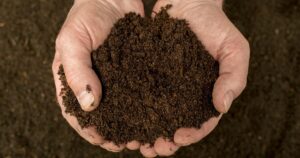
Soil matters, ladies and gentlement, and it’s a huge difference whether your garden’s soil is sand or loam (just to name a few). Determining your soil type is the first step to learning what you can grow and adjusting it to your plants’ needs. In this post you can learn more about the different types of soil and their characteristics.
Solution: There are soil test kits available online and in nurseries. Once you know what soil type your garden has, you know what plants will thrive there and what you can do to spruce it up for other vegetables.
#4 Not knowing your hardiness zone
Hardiness zones are determined by the annual minimum temperature of a region, thus telling you what plants will thrive and survive there. Not knowing your hardiness zone may tempt you to grow vegetables outside that will not have enough sun hours and high enough temperatures to mature fully and produce a good harvest.
Another important piece of information you’ll get is the last frost date for your region. After that date, it’s safe to plant sensitive veggies like tomatoes and cucumbers outdoors. Any earlier can kill your plants (see #10)
Solution: Go to plantmaps.com and check out your hardiness zone.
#5 Using the wrong plants
First of all: there is no such thing as “wrong” plants but rather plants not suitable for your hardiness zone. Once you know what zone you live in, you’ll know what plants you can grow in your region
Tempting as it may be to go for sun-loving tomatoes in zone 4, you won’t be happy with the outcome if you plant them outside. The time frame of optimal conditions will simply not be long enough for them to ripen all their fruit.
Solution: Check your hardiness zone and choose your plants accordingly. If necessary, make adjustments like adding a greenhouse or a cold frame to prolong your season and create a better climate for sensitive veggies like tomatoes and peppers if necessary.
Check your hardiness zone and, if necessary, make adjustments l. Alternatively, cultivate sensitive plants in pots and bring them indoors as soon as it gets too inhospitable for them outside.
#6 Sowing/planting in wet and/or cold soil
One year, spring wouldn’t come and when around mid-April the sun finally started to come out, I was so anxious to make up for the “lost” time that I started to sow into the still wet and cold soil. Needless to say, it didn’t work to smear the seeds in. Germination was practically zero and I had to do it again a few weeks later when the soil was finally dry and warm.
Solution: Wait until the soil is sufficiently dry and warm in spring before sowing and planting.
#7 Poor soil preparation
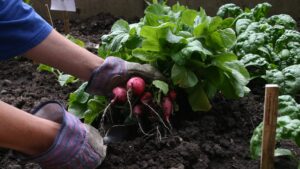
Plants draw nutrients from the soil and to make sure that your garden is thriving next year, you’ll have to prepare your soil to fill it up with nutrients for the upcoming season. Gardeners who neglect this task, will soon have only weak plants with little to no harvest.
Solution: When everything is harvested in autumn, it’s time to put your garden to sleep under a thick blanket of mulch or green manure like phacelia. This not only protects the soil but adds nutrients when the organic matter decomposes.
Additionally, work in compost or well-rotted manure in spring before you start sowing and planting to further enrich the soil with nutrients.
#8 Poor weeding
Weeds compete with your veggies for nutrients, water and space and believe me: weeds clearly have the advantage! That said, it should go without saying that sowing and planting between weeds will neither make you nor your plants happy.
Solution: I know it’s tedious but your garden beds must be absolutely weed-free before you start sowing and planting. When you cover them with a thick layer of mulch, there won’t be many weeds and this task will be done in no time.
It’s best to weed at the same day you sow and plant. That way, the weeds need some time to start growing again and won’t compete with your vegetables for nutrients.
If you mark the sowing rows, you can weed in between without accidentally ripping out your soon-to-be-growing plants.
#9 Seed-starting too early or too late
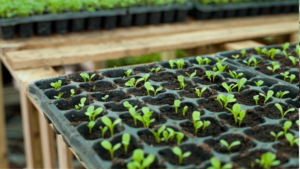
The first sunny days in January and I want to seed-start whatever seeds I’ve got in my storage boxes. But while there are some vegetables you can start as early as January, it would be too early for most of them. Take tomatoes for example. Seed-started in January they would only become leggy and too weak to hold their own weight by mid-May when we can finally plant them outdoors.
If, on the other hand, we seed-start them in April, there won’t be enough time for them to mature and produce a good harvest.
Solution: If in doubt when to seed-start vegetables, check your hardiness zone first and then have a good look at the seed packages where you’ll find the necessary information.
#10 Planting too early or too late
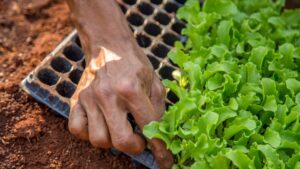
Sunlovers like tomatoes, peppers and eggplants cannot be planted outdoors before the last night frosts are over; otherwise, they will die. Spinach and some lettuce varieties, on the other hand, cannot stand temperatures above a certain degree without producing blooms.
The right timing when planting is equally important as with seed-starting.
Solution: Check your hardiness zone for the last frost dates and either look at seed packages for ideal planting time or ask in your local nursery.
#11 Planting too shallow /too deep
If you plant too shallow, your vegetables will have trouble with rooting and become prone to falling over. Planting too deep, on the other hand, will result in restrained growth and small plants.
Solution: As a rule of thumbs, plant your vegetables as deep as they were in the pots. Exceptions are tomatoes, which you can plant twice as deep as the pot they were in before and bulb celery which you should plant higher than the pot level.
#12 Ignoring spacing
Cabbages should be planted 50 cm (20 inches) apart, but nursery (or seed-started) plants look so small that sometimes we underestimate the space they require when fully grown and plant them too close together.
Solution: As with seed-starting and planting time, you’ll find the ideal spacing for your vegetables on the seed packages. Alternatively, ask in your local nursery.
#13 Not observing crop rotation
I get it: the plan for your vegetable garden has worked out wonderfully and you want to copy it every year. Never change a winning horse, right?
Wrong! Planting the same kind of vegetables in the same place will leach out the soil and result in reduced to no harvest.
Solution: Observe the plant families and rotate your crops every year. Where last year you got strong uptakers (like cabbage or tomatoes), you’ll put plants with low nutrient uptake this year (e.g. beans or peas). Next year, you’ll follow that with medium uptakers like carrots or onions.
#14 Monoculture
If you grow only one sort of vegetable in a bed (yes, that’s monoculture), they are more likely to get diseases or be slaughtered by pests. Mixed culture is the keyword here!
Solution: Mix plants that go well together, like carrots and onions who keep pests away from each other. Find further examples of great companions here.
#15 Watering mistakes
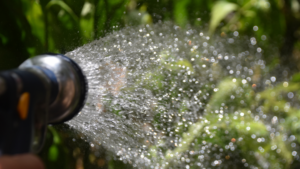
Watering, it seems, is the most favourite task of many gardeners. They water until their plants cry for their life jackets and start singing “My heart will go on”. Plants can drown, too, you know.
Not watering at all, however, is no solution either. Water is what keeps the plants’ metabolism running. If they get not enough water, plants will die.
Solution: Water thoroughly after sowing and planting and then: don’t. Only water again if the soil is really dry and your plants show signs of wilting. That way, they grow deeper roots which makes them sturdier and healthy.
Additionally, cover the soil between the plants with mulch (see next point).
#16 Not using mulch
My granny and my mom prided themselves with their “clean” vegetable gardens where there were only plants and (weed-free) soil. The amount of time it cost, however, to keep this soil weed-free and to water the plants – especially during hot summers – was immense.
In my garden today, the soil is almost always covered in mulch, even in winter. It keeps the weeds at bay, the soil moist and produces compost when it decomposes.
Solution: Mulch your beds thickly as soon as the plants are about 10 cm (4 inches) high. Good mulch material are wood chips, grass clippings, leaves and half-rotted compost.
#17 Improper fertilisation

“The more the better” is not true when it comes to fertilisation. Some plants need many nutrients, others not so many. Some need more nitrogen, while others need a healthy dose of phosphorous and potassium.
Also, the timing of fertilisation is important. Giving too much too soon or all in one dose will result in weak (or even dead) plants.
Solution: Add a healthy dose of organic or mineral fertiliser (for example well-rotted manure or rock powder) when planting and get acquainted with your vegetables’ needs. Tomatoes, for example, want phosphorous and potassium about 4 – 6 weeks after planting to produce many fruits. When in doubt, rather use less fertiliser.
#18 Not using fencing
As you know, my vegetable garden is situated on a meadow at the outskirts of my village. If I hadn’t installed a (sturdy) fence, the deer, rabbits and even the foxes would eat my produce while the dogs and cats would be happily digging holes and misusing it as a loo.
Solution: Depending on where your garden is, set up a fence to keep off animals.
#19 Not controlling pests
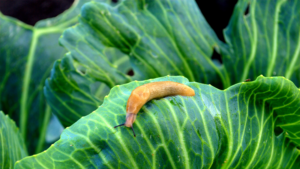
One snail is not the end of the world but have you ever seen just ONE snail? Me neither! When they come, they come in droves like every pest under the sun.
Solution: Regularly check on your garden so that you can intervene at the early stages of a pest invasion and prevent a plague.
Additionally, apply the rules of companion planting to repel certain pests.
#20 Not using pollinators
No fruit without pollinators, right? So make sure you’ve got plenty of those flowers in and around your garden that attract pollinating insects.
Solution: Flowers and herbs like nasturtium, basil and calendula are not only a beautiful sight in your garden but also help attract pollinators for all your fruit vegetables like tomatoes, peppers and cucumbers. Make sure to integrate bloomers in your vegetable garden.
#21 Not pruning

This mostly applies to fruit trees and bushes but also to vegetables like tomatoes. Letting them grow as they like will considerably reduce your harvest.
Solution: Fruit trees and bushes are best pruned in winter while they’re dormant. With fruit trees, cut off all branches that grow downwards, inwards or obstract each other. With fruit shrubs, cut off old branches at soil level. And here is a comprehensive guide on how to grow tomatoes successfully with a detailed explanation on how to prune them.
#22 Harvesting too late
It’s interesting to see how many gardeners hesitate to harvest until it’s (almost) too late. If not harvested at the right time, radishes and kohlrabi will get “woody”, lettuce will suddenly sprout blooms and tomatoes will become mushy.
Solution: Always harvest as soon as your vegetables are ripe. That way, you’ll not only have nutrient-dense vegetables but often will induce your plants to produce more fruit.
#23 Not enjoying gardening
In my opinion, this is the most important point! Don’t get all uptight when it comes to gardening. There will always be something that won’t turn out quite as expected. After all, it’s Mother Nature we are working here with.
So relax and, while trying to do your best, enjoy your garden. Take your time to sit there in the sunshine, admire all that grows, listen to the birds and savour your harvest! Our gardens should always be our happy places.

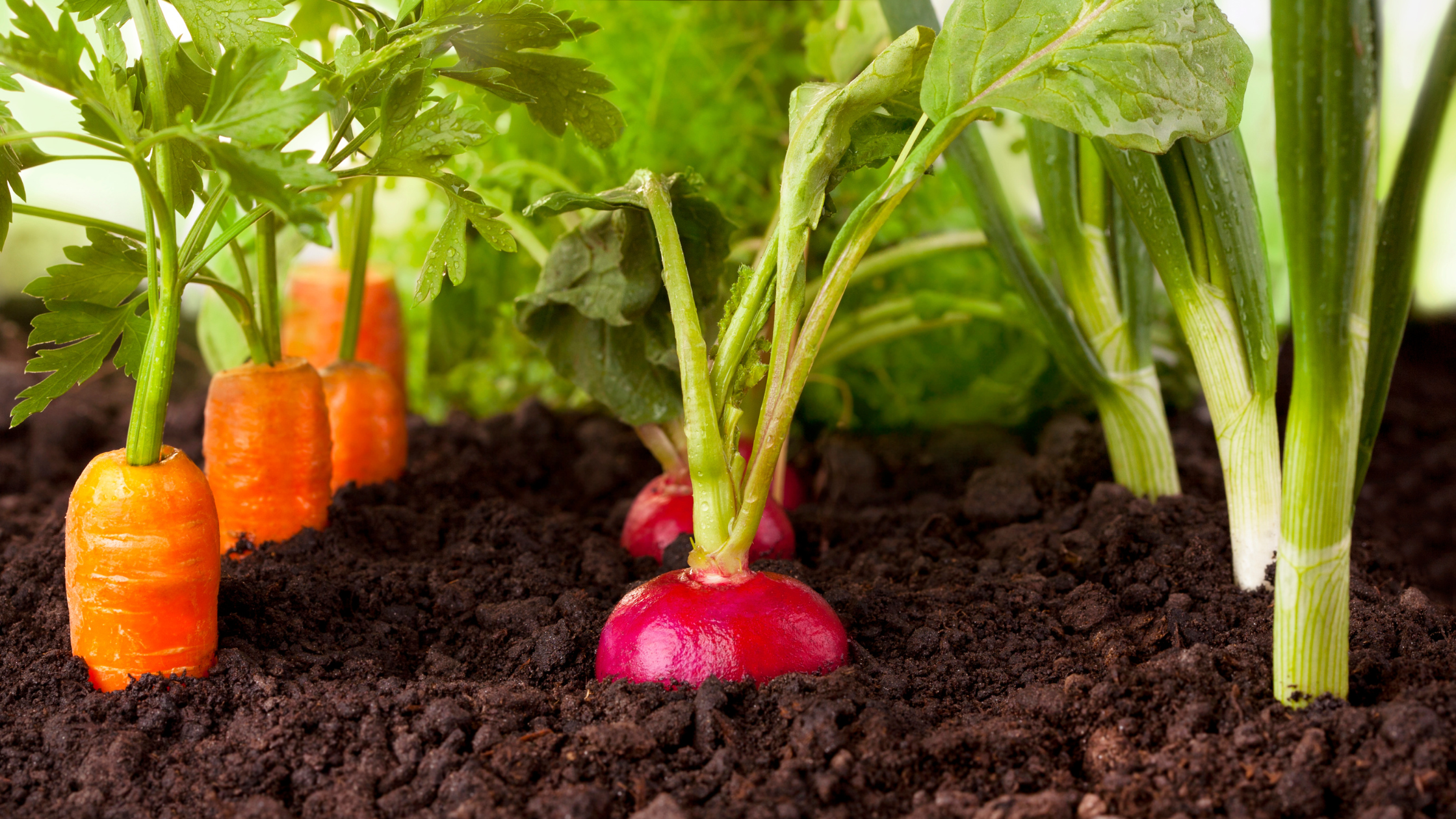
0 Comments